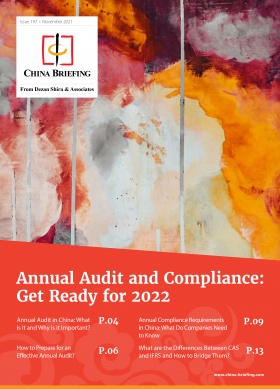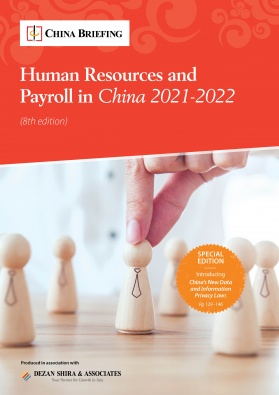China Visas Explained
Editors: Ramya Bodupalli and Alexander Chipman Koty
Foreign nationals visiting China generally need to acquire a visa before entering the country, except for special circumstances allowing for visa-free entry. China issues several different types of visa for various purposes.
Chinese visas fall into two categories: ordinary and diplomatic visas. The ordinary visa consists of several types, which are respectively marked as L, F, M, Z, X1, X2, C, J1, J2. G, D, Q1, Q2, S1, S2, and R.
The Special Administrative Regions of Hong Kong and Macau have separate immigration and visa procedures.
Here, we provide details on all of the different types of visas and their applications and permitted uses. Summaries of the Z Visa, China’s main work visa, and the M Visa, China’s business visa, and the required supporting documentation for both are also provided.
L Visa – Tourist Visa
The L Visa is issued to foreigners who enter China temporarily for tourism. Tourist visas are typically offered on a single-entry, double-entry, or multiple-entry basis with the duration of stay ranging from 30 days to 90 days. Citizens from the US and Canada may be eligible for multiple-entry L-Visas valid for 10 years.
For those who wish to travel to Tibet, an approval notice from the China Tibet Tourism Bureau is required in order to apply for a tourist visa.
F Visa – Non-commercial Visit Visa
The F Visa is issued to foreigners who are invited to China for non-commercial purposes, such as research, lectures, and cultural exchanges. The F Visa previously covered a wider range of activities when it was known as China’s business visa, before being largely replaced by the M Visa. Single-entry and double-entry visas are available. The duration of stay typically ranges from 30 days to 90 days.
M Visa – Business Visa
The M Visa is issued to foreigners visiting China for business and trade purposes. It is suitable for foreigners who make frequent work-related visits to China, but spend less than six months in a given year in the country, and are not employed or paid by an entity incorporated in China. More information on the M Visa can be found below.
Z Visa – Work Visa
The Z Visa is issued to foreigners who are taking up a post or employment in China, and their accompanying family members. The Z Visa is the most common type of visa used by foreigners working in China. More information on the Z Visa can be found below.
X Visa – Student Visa
The X Visa is issued to foreigners who come to China for studies or fieldwork. While holders of X Visas do not have working rights, they may be able to undertake internships if authorized by their educational institution and other relevant authorities.
The X1 Visa is issued to students whose study period is more than 180 days.
The X2 Visa is issued to students who intend to study for less than 180 days.
C Visa – Crew-member Visa
The C Visa is issued to crew-members on international aviation, sea navigation, and land transportation missions, and their accompanying family members.
J Visa – Journalist Visa
The J Visa is issued to foreign journalists who are working in China on either a temporary or permanent basis.
The J-1 Visa is issued to foreign journalists who are posted to China for at least one year.
The J-2 Visa is issued to foreign journalists who are on temporary assignments in China for up to 30 days.
G Visa – Transit Visa
The G Visa is issued to foreigners who transit through China. Since the cost and application procedure to acquire a G Visa is similar to acquiring an L Visa, travelers tend to opt for an L Visa rather than a G Visa. Several cities in China also offer visa exemptions for travelers in transit.
D Visa – Residence Visa
The D Visa is issued to foreigners who plan to live in China permanently. This visa is also known as “the Chinese green card” and is notoriously difficult to acquire.
Q Visa – Family/Personal Visit Visa
The Q Visa is issued to foreigners who are visiting family members of Chinese citizens, and to foreigners who are spouses of Chinese citizens, including those who intend to visit China for personal purposes, including foster care.
The Q1 Visa is issued to family members of Chinese citizens or permanent residents of China who intend to stay in China longer than 180 days. The Q1 Visa has a single entry. Upon entry, the holder must apply for a residence permit within 30 days.
The Q2 Visa is issued to family members of Chinese citizens or permanent residents of China who intend to visit China temporarily. The Q2 Visa can be multiple entry, and valid for up to 10 years for US and Canadian citizens, carrying a stay of up to 180 days per visit.
S Visa – Relatives of Foreigners
The S Visa is issued to relatives of foreigners who are working or studying in China. It is the equivalent of the Q Visa for family of foreigners living in China long-term.
The S1 Visa is issued for a stay more of than 180 days. The S1 Visa has a single entry, and holders must apply for a residence permit within 30 days of entry.
The S2 Visa is issued for a stay of 180 days or less. The S2 Visa can be multiple entry, and valid for up to 10 years for US and Canadian citizens, carrying a stay of up to 180 days per visit.
R Visa – Highly Qualified Persons
The R Visa is issued to highly qualified individuals whose skills are urgently needed in China. This refers to Tier A talents under China’s new tiered work permit classification system. Determining who is regarded as ‘high level personnel’ is strictly regulated.
Last year, the government relaxed rules for foreign top talents, enabling them to obtain multiple-entry R Visas valid for either five or 10 years, with a maximum stay per entry of 180 days. Spouses and children of R Visa holders will also be allowed to enter the country on an R Visa. Visa processing time in this category has also been expedited.
Diplomatic and Service Visa
Issued to foreign government officials and the staff of diplomatic missions and of the United Nations who travel to China for official missions or accreditation.
About the Z Visa
The Z Visa, also known as the a work visa, is issued to foreigners employed by a company that has been incorporated in China.
Z Visas are issued prior to entry into China upon the submission of supporting documentation by the employer and related government departments. Upon arrival, the Z Visa holder must then obtain work and residence permits.
When applying for the work permit, the employer’s business license, organization code certificate, tax registration certificate, and FIE approval certificate (if the employer is foreign-invested) must be provided, among other required documents.
Where a foreigner changes his/her job but continues to hold a valid work permit, he/she can undertake an “employer change” procedure with the government to renew the work permit. The actual procedure for the renewal may vary from city to city. In Shanghai, the main documentation required for such application includes:
- Two copies of the foreigner employment application form;
- A release letter from the previous employer (if the foreigner is relocated to Shanghai from a different city, government-released proof of work permit relocation/cancellation shall be provided);
- Valid business license, organization code certificate, FIE approval certificate (if the employer is foreign-invested) of the new employer;
- A curriculum vitae in Chinese, including the highest academic degree obtained and complete work experience;
- Work-related qualification certificate or proof of past work experience (issued by previous employers) that is related to the new employment;
- Academic qualifications;
- Employment contract with the new employer;
- The current work permit;
- Valid passport, residence permit, and employer’s employment permit;
- Three passport photos; and
- Other documents required by the government.
About the M Visa
The M Visa, or business visa, was introduced in 2013. Before the introduction of the M Visa, the F Visa was known as China’s business visa.
Those seeking an M Visa must be invited to the country for business purposes by a China-based company. The M Visa is ideal for foreigners who visit China frequently for short business trips.
The visa is issued for a period ranging from one month to one year. This can be extended under certain conditions. Single-entry, double-entry, and multiple-entry visas are available. Applicants from the US and Canada may obtain M Visas valid for up to 10 years.
The documentation required for applying for M Visas are:
- Passport, along with a photocopy of the name page;
- Filled in visa application form;
- One recent passport photo;
- Invitation letter from Chinese business based in China; and
- Submission of Visa Service Request Form.
Additional information and documentation may be required depending on the applicant’s country of origin, where the application is being done, and where the applicant intends to visit.
Prospective visitors to China are advised to contact their local Chinese embassy or consulate and obtain professional advice when dealing with visa-related procedures, as requirements may differ on a case-by-case basis.
(This article was originally published on December 30, 2011. It was updated on December 27, 2017 and October 16, 2019.)
About Us
China Briefing is produced by Dezan Shira & Associates. The firm assists foreign investors throughout Asia and maintains offices in China, Hong Kong, Indonesia, Singapore, Russia, and Vietnam. Please contact info@dezshira.com or visit our website at www.dezshira.com.
- Previous Article Hebei’s Minimum Wage to Increase from November 1
- Next Article China’s New Foreign Investment Law: A Backgrounder









